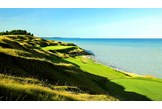USPGA: 12 things you didn’t know about Whistling Straits
Published:
Whistling Straits is one of the most spectacular courses in the world. It also happens to be one of the most demanding as the players lining up in the US PGA Championship, from August 13-16, will no doubt testify.
-
The course is no stranger to big events. It’s hosted the PGA twice before, in 2004 and 2010. Both were decided by a play-off, when Vijay Singh and Martin Kaymer won. The 2020 Ryder Cup will also be hosted at Whistling Straits.
-
The resort (there’s one other course) has been created by one of the richest men in the USA, billionaire bathroom furniture magnate and golf nut Herb Kohler (who also owns the Old Course Hotel in St Andrews).
-
There are 967 bunkers on the course. Some are barely big enough to fit a rake in; others run the entire length of a fairway. When they built it, 7,000 truck loads of sand were brought to the site. Maintenance of most bunkers is intended to be natural, primarily the wind.
-
Dustin Johnson famously didn’t make the 2010 play-off after grounding his club in a bunker on the final hole. That shouldn’t happen again – even though the same rules apply. Rory McIlroy said: “The players are much more aware of what they can and can’t do in those sandy areas,” he said. “There were notices up in the locker room. If you’re paying attention, you should be aware of it.”
-
Before Pete Dye worked his magic, it was a pancake-flat bit of farmland.“We built this from clay,” said Dye. “We had to haul in all the sand. Drained each bunker, too. We’ve got more money in drainage pipe than we do in sand.”
-
Dye added a head-deep pot bunker in the middle of the sixth green. “I compare it to the bunker at the Road Hole of the Old Course,” says Kohler. “It makes the easiest hole (355 yards) at the beginning of the round more interesting.”
-
“Pete makes you think,” says defending champion McIlroy of Dye. “He likes to intimidate you and forces you to be confident in your game. But he also likes to give you a chance to save your par if you misfire. Earlier on in my career, I’d get onto a tee on a par 4 or par 5 and just grab the driver to hit it as far as I possibly could. I’ve just figured a way to play his courses now and find my spots. Discipline is the key to play Pete’s courses.”
-
“The guys who have played here before and experienced it will certainly have an advantage,” says Mike O’Reilly, Whistling’s head pro. “It’s a case of seeing the lines you want to hit and trusting it.”
-
The finish is one of the toughest in Major golf, with a 518-yard par 4 (15th), a 220-yard par 3 (17th) to a green with a 20-foot drop on the left side and the 500-yard par-4 18th, which is guarded by a brook. “The most important shot here is the teeball,” says O’Reilly. “It will be long – roughly 7,500 yards – with some very challenging par 4s. But if players can keep the ball on the fairway, the course is very playable.”
-
“The greens are very big with some more severely undulating than others,” adds O’Reilly. “But they’re all big, so if you hit the green it doesn’t mean it’s an automatic two-putt. You’ve still got some work left. They’ll be firm and fast, 12-13 on the stimpmeter.”
-
Whistling Straits’ two miles of Lake Michigan shoreline are patrolled by a flock of 29 Scottish blackface sheep that spend the day on the course, eating, drinking and fertilising the fairways.
-
This is one of the few Major courses in the US you can actually play… if you hand over the $385 green fee.

